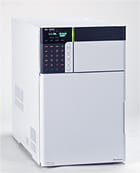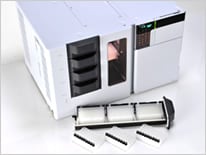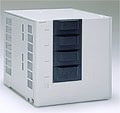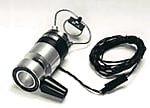Autosampler
Nexera Series

SIL-30AC
SIL-30AC Autosampler
The total-volume injection SIL-30AC autosampler features a pressure tolerance of 130 MPa as well as the world’s fastest sample injection (10 seconds), which dramatically reduces the total cycle time. It includes auto pretreatment and overlapping functions as standard, and an optional loop-injection method configuration to minimize delay volume. With reduction of the needle contact area, special coatings, surface treatments, and a new needle seal, the SIL-30AC reaches a new level of low carryover performance, which is especially beneficial for LCMSMS analysis. In addition, the included sample cooler features a dehumidifier function for storing samples at a constant temperature between 4°C and 40°C.

Rackchanger II and SIL-30AC Autosampler
The rackchanger unit replaces the microplates on autosampler racks to enable samples to be continuously analyzed . It allows loading up to 12 microplates inside the unit (maximum 4608 samples). Samples can be temperature-controlled with a block heating/cooling system (with dehumidifier function and 4 °C to 40 °C range) not only to refrigerated temperatures, but also to stable temperature levels near room temperature.
| Method | Variable sample injection volume and total volume direct injection |
|---|---|
| Allowable Operating Pressure | 66 MPa |
| Injection Volume Range | 0.1 µL to 50 µL (0.1 µL to 100 µL with option) |
| Number of Samples Processed | 175 (1-mL vials), 105 (1.5-mL vials, 70 for 20AC), 50 (4-mL vials), 192 (two 96-well MTP/DWP), 768 (two 384-well MTP/DWP) Besides these, ten 1.5-mL vials can be used |
| Injection Volume Precision | Max RSD 0.3 % (normally max 0.2 %: depending on specified conditions) |
| Cross-Contamination | Max 0.005 % (depending on specified conditions, without rinsing, normally max 0.0035 %) |
| Needle Rinsing | Freely settable, before or after sample injection |
| Operational Temp. Range | 4 - 35 °C |
Prominence Series
SIL-20A/20AC Autosampler

SIL-20A
The SIL-20A is a total volume injection type (direct injection) autosampler that enables high-speed injection and multi-analyte processing. Materials used in needle, valve, and other flow lines were closely considered and a needle rinsing function is provided to carefully minimize cross-contamination (carryover), which is especially useful for high-precision LC-MSMS analysis. The SIL-20AC includes a sample cooler that features a dehumidifier function for storing samples at a constant temperature between 4 °C and 40 °C.

Rack Changer
The rackchanger unit exchanges the microplates on autosampler racks to enable samples to be continuously analyzed. 12 plates can be mounted inside the main unit and stored under refrigerated conditions.
| Method | Variable sample injection volume and total volume direct injection |
|---|---|
| Injection Volume Range | 0.1 µL to 100 µL (0.1 µL to 2000 µL with option) |
| Number of Samples Processed | 175 (1-mL vials), 105 (1.5-mL vials), 50 (4-mL vials), 192 (two 96-well MTP/DWP), 768 (two 384-well MTP/DWP) *Twelve 96-well MTP/DWP in the rackchanger |
| Injection Volume Precision | Max RSD 0.3 % (under specified conditions) |
| Cross-Contamination | Max 0.005 % (naphthalene and chlorhexidine) |
| Needle Rinsing | Freely settable, before or after sample injection |
Comparison for Autosampler Selection Autosamplers can be selected according to objectives.
| Model Name | Features/Applications | Injection Volume (µL) | Number of Vials | Microplate Capacity | Main Liquid Contact Surface Materials |
|---|---|---|---|---|---|
| SIL-20A | Outstanding reproducibility and accuracy for trace volume injection. A needle rinsing function is included standard to minimize cross-contamination (carryover). It also allows high speed injection. (direct injection, specialized needle coating, and PEEK rotor) | 0.1 to 100 (max 2000) | 175 (1 mL), 105/70 (1.5 mL), 50 (4 mL) | Cools max two 96/384-well plates | PEEK, (SS) |

Manual Injectors
7725/7725i,
8125 (semi-micro),
9725/9725i (PEEK)
3725i (Preparative)
News / Events
-
New Technical Report is available, Optimization of Supercritical Fluid Extraction Parameters for Vitamins D2, D3, and K1 from Pharmaceutical Preparations
New Technical Report is available, Optimization of Supercritical Fluid Extraction Parameters for Vitamins D2, D3, and K1 from Pharmaceutical Preparations
-
New Tips & Tricks is available, Automated Dilution and Preparation of Standard and Sample Solutions for Analysis
-
Shimadzu Corporation has released LabSolutions Detect, a software with AI Functionality to support Anomaly Detection for Liquid Chromatographs (LC).
LabSolutions Detect transforms your LC data review process by visualizing differences between accumulated reference data and daily sample data.
-
New Technical Report is available, A sustainable analytical approach for detecting extra virgin olive oil adulteration using Nexera™ UC
In this study, a fast, simple and green methodology was optimized to detect intentionally adulterated extra virgin olive oil EVOO with cheaper seed oils at different levels by means of subcritical fluid chromatography (subFC) with UV detection, followed by statistical analysis.
-
Shimadzu has released the new integrated LC system, i-Series.
The new i-Series integrated LC: Sustainable design. Reliable results. Uncompromising performance.
-
Core-shell Column: Analysis Basics Now Available.
Discover easy-to-understand insights into the fundamentals of analysis.


